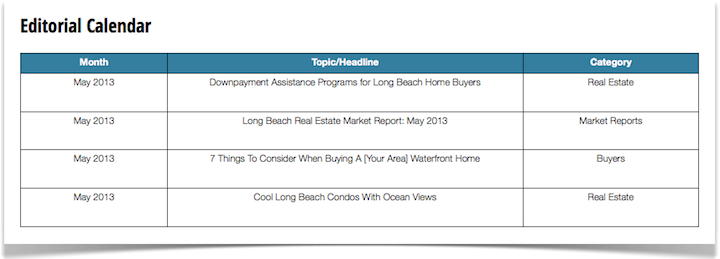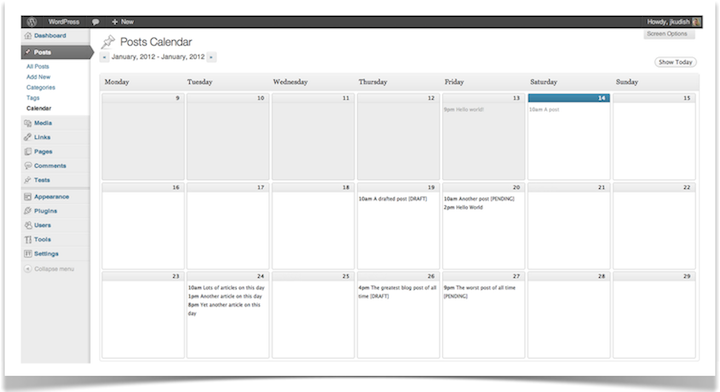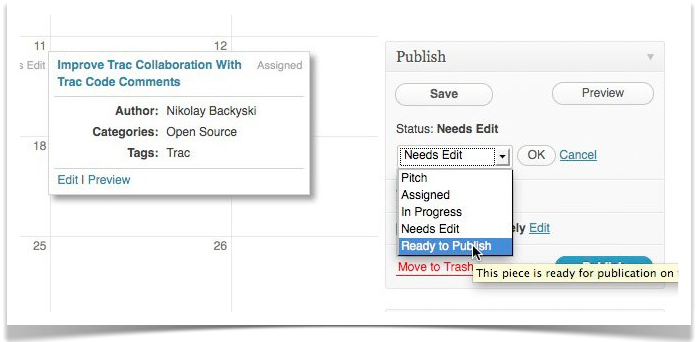Great content helps you:
- Build trust. Great content educates and informs your reader. The more you continue to develop great content, the sooner they’ll come to know, like and trust you.
- Generate leads and turn prospects into customers. The more you continue to create useful content, the more likely people are going to want to buy from you.
- Outrank the competition. In order to outrank the competition, you’re going to have to continuously develop great content. Content that speaks the language that your customers are using to search for information online.
The key to executing a successful content strategy is consistency.
You can’t build trust, generate leads and outrank the competition if you don’t continue to develop useful content, consistently, over time.
Why You Need An Editorial Calendar
An Editorial Calendar is really just a publishing schedule. Using an editorial calendar is going to help you in a couple of ways…
1. An editorial calendar will help keep you accountable.
If you set a schedule early on you’re more likely to stick to it knowing that you have to publish something on this date and that date. You know that you have to set aside 3-4 hours a week to publish 1-2 posts for the following week.
If you’re smart about this, you’ll simply make the time a part of your weekly “prospecting time.”
It finally dawned on me that I had to look at developing content as prospecting time. I made a decision to allocate an hour a day for research and writing. My goals was to have 3 to 5 posts a week, especially when my blog was still a baby. – Irina Netchaev, PasadenaViews.com
The key here is to be realistic with your expectations.
What I mean is, only commit to a schedule that you know you can keep. If you over-commit yourself, it’s easy to develop a surrendering mindset. “Oh, it’s too much work, I’ll get to it next week.” One week goes by and then the next and you’ve produced very little content.
On the other hand, if you develop a schedule you can regularly keep, you start to build momentum. Suddenly, 2-3 blog posts per week doesn’t seem like a daunting task, you’ve turned it into a habit.
2. An editorial calendar will help you get organized and on track with your content marketing goals.
The first step to developing an effective content marketing strategy is identifying your content marketing goals. What is it exactly that you hope to accomplish? Or are you just writing for the sake of writing to help readers pass time?
Here’s a few content goals that come to mind…
To Build Trust & Rapport
People do business with people they know, like and trust. But that process doesn’t just happen overnight. It happens over time.
You create one piece of content that somebody resonates with and finds useful. Then another, and another.
After a few interactions with your content, they might subscribe to your newsletter. A few weeks, maybe a month goes by and you’ve continued to deliver highly relevant and useful information to their inbox.
After a short while, they’ve begun to know, like and trust you.
Before you publish something, ask yourself: is this useful/helpful to my audience?
To Build Your Search Engine Rankings
The foundational element of a successful 21st century real estate website is content. Not just any content, but valuable, information-rich content that’s tailored to speak the language that your customers are using to search for information online.
As you start to fill out that editorial calendar with article topics, ask yourself, how are my customers searching for information online? What “search phrases” are they using to find out about this neighborhood? How are they searching for homes in my area?
Then, you can write your headline titles in a manner that’s consistent with how they’re searching online.
To Generate Leads
There are two types of content:
- Content that attracts, engages and converts site visitors into customers. And,
- Filler content. Content that you write just for the sake of writing something.
If you’re writing for the sake of generating more leads for your real estate business, then you should really be focusing on #1.
As you fill out your editorial calendar with article topics for the month, ask yourself: is this the type of content that attracts, engages and converts site visitors into customers? Or is this filler content?
If it’s in the latter group, you know what to do.
Having an editorial calendar is going to help you keep your content marketing goals in check. As you start to fill out your weekly/monthly calendar with blog post ideas, ask yourself, is this helping me meet my content marketing goals?
If not, you really need to sit down and consider your audience. What types of things are they interested in learning? What do they want to know/learn about the community? What do they need to know about buying/selling real estate in your area? Once you know the answer to these questions, you can start to write better content that helps your audience and that in turn, helps you grow your business online.
How To Create A Successful Editorial Calendar
You don’t need any special software to create an editorial calendar. A simple pen and paper will do, or a weekly/monthly planner. Or, if you prefer to keep things digital, there’s a couple of WordPress plugins that might do the trick.
Here’s what you should include in your editorial calendar:
- The post date.
- The post title.
- The category.
- Keywords.
That’s it. Keep it simple.
If you’re running a multi-author blog here’s a few additional items to include:
- The post author.
- The post date.
- Status (published or in progress).
The end result should look something similar to this:

It’s just a weekly/monthly snapshot of what you expect to cover on your real estate blog. Remember, having that calendar is going to help you stay on track and consistent with your content strategy.
If you’re running light on topics one week, look at your audience… What types of questions are they asking about the current market that you can provide answers to? Then, start to fill in the gaps with post titles.
If you’d rather keep things digital and are looking for a simple way to manage your content within WordPress, try the Editorial Calendar Plugin for WordPress by Stresslimit.

If you run a multi-author site, I recommend using: Edit Flow. This editorial calendar plugin for WordPress provides a ton a features including a month-by-month look at your content, custom statuses (pictured below), editorial comments and more. It’s perfect for managing that editorial workload amongst a team of writers.

Building Momentum
Every time you publish something new, check it off your calendar. Highlight it, or put a checkmark next to it. It’ll be your way of saying, “mission accomplished. I published something new today!”
That might sound a little silly at first, but do it anyway. The reason is, it builds momentum. And that momentum is going to help you keep moving forward as you turn your blog into a content marketing machine.
At first, writing might seem like a difficult, daunting task. But once you’ve written 20-30 blog posts, writing gets easy. And after a few months of publishing 2-4 posts per week on a consistent basis, you’ve got yourself a site that’s ranking well in search engines, building trust with new readers and generating a steady flow of leads.
If you’ve been at this for a while and are sitting there wondering why things are going the way you planned, maybe all you need to do is get it on the calendar and get organized. That one little step goes a very long way.




